
|   |

|   |
Nritya Parva 2015 at Guwahati - Nita Vidyarthi e-mail: nitavidyarthi@gmail.com Photographs courtesy: Sattriya Kendra, Guwahati January 14, 2016 Organizing and conducting the annual “Nritya Parva” is a major task undertaken by the Sattriya Kendra Guwahati of the Sangeet Natak Akademi. The dance festival presents solo, duets, trios and group performances in the evening sessions together with inspiring seminars and lecture demonstrations in the mornings on the various aspects of the Sattriya tradition like mask making - introduced for the first time this year, by scholars - seasoned performers, music composers and other experts. The 14th Nritya Parva (Nov 16-18, 2015) at Rabindra Bhawan, Guwahati mounted an exclusive photo exhibition on Sattriya dance, music and theatre, drawing from photographs from the Kendra’s archives apart from the evening’s dance performances and ritualistic Gayan-Bayans. Masks and other artifacts like traditional jewellery were also on display. Altogether, 4 solo dancers, 3 duets, 5 trios, 4 dance groups, 4 Gayan-Bayan groups and one Ojapali group from different parts of Assam participated in the performances. 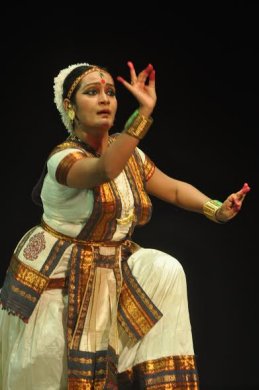 Meernanda Barthakur 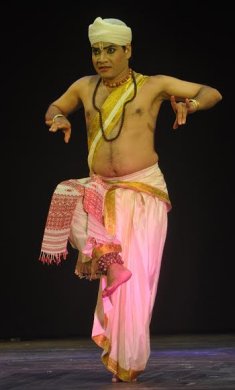 Naren Chandra Baruah Well-known dancers like Meernanda Barthakur and Naren Chandra Baruah presented impressive solos. While Guru Jatin Das’s Sattriya Akademi, Rangayan’s Dasavataar choreographed by Sharodi Saikia (who doubled up as a fine sutradhar) entertained, Bargeet Vidyalaya Barpeta and Nrityanjali’s trios appealed and the Gayan-Bayans touched the soul in the four evenings, the three morning sessions were an intellectual exercise and necessary insight into the grammar and aesthetics of Sattriya in totality. 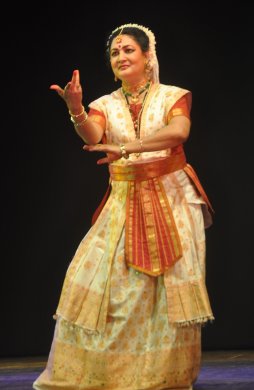 Sharodi Saikia The present discussion concentrates on the three morning sessions at the Assam State Museum that focused primarily on the theoretical aspects of the tradition and concerns to preserve its sanctity and grandeur and was apparently enriched by powerful demonstrations and lively interactive sessions. The first morning opened with a paper presentation on ‘Bhariman of Sattriya dance: The Sastric Base’ by Dr. Tanuja Bora, Associate Professor in English, Swahidpeoli Phukan college, Namti. Of the vast repertoire of footwork of Sattriya dance, the biggest group of footwork units of the dance form is the ‘khoj’ or bharimans and there are seventy of them. Dr. Bora’s lecture effectively analyzed this vernacular term, which denotes both ‘caris’ and the bigger units emerging out of caris and other footwork, particularly the paks (bhramaris) in Sattriya on the basis of Natya Sastra, the Abhinaya Darpanam and the Sangita Ratnakara. A huge number of caris in Sattriya have their origin in the treatises. Bora mentions that some of these are the same as or are very close to their counterparts in the treatises, while others are used with minor differences in hand gestures or limbs. Bora described the treatise based caris using the names of their sastric counterparts. While Natya Sastra enumerates sixteen Bhaumi (earthly) caris and sixteen Akasiki (aerial) caris (as also in Sangita Ratnakara), Sattriya makes use of eleven earthly and eight aerial caris out of them and explained in detail, the cases where Sattriya follows the description of Natya Sastra and where it is incorporated or not. She offered a systematic presentation and description of all these caris derived from Natya Sastra and also the eight caris derived from the Abhinaya Darpana, all of which are used in Sattriya. It was useful to know from her that “apart from enumerating the caris of the margi tradition, the Sangita Ratnakara describes fifty four caris belonging to the desi variety and a good number of them have a close affinity with those used in Sattriya.” It was mentioned that some of the footwork of the dance form are found both in the treatises and in the folk dances of the region including Bihu but the virtual source of some footwork is difficult to trace. In response to the hard work behind Dr. Bora’s presentation the absence of a codified text was strongly felt and Sattriya’s own “Sastra” was suggested as a requirement instead of a mere compilation and comparison with authoritative treatises on Indian dance. However Bora’s effort is helpful in identifying the Sattriya caris with those of the three reference texts. Guru Jatin Goswami added that there were two aspects to the Sattriya dance, Vaidik that is “likhita” (written) and Loukik that is “alikhita”(unwritten, generally referring to oral traditions). There are many gurus who do not know anything about the Natya Sastra and traditional people do not depend on it either or some don’t believe in it. They only know “Bhariman” which is their own ‘word’. “But one must know the grammar and the format,” he stresses. He was hopeful that a proper guideline will definitely develop with time. 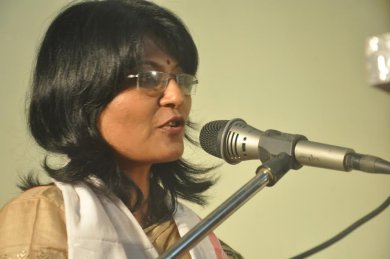 Dr. Tanuja Bora 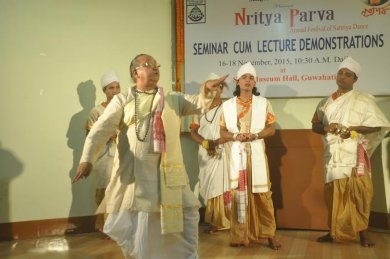 Manik Bora Borbayan It was a privilege to hear Manik Bora Borbayan from Titabar and watch his short but wonderful performance in the second half of the first morning illustrating his presentation entitled the ‘Sattriya Ojapali tradition of Assam and its musical analysis.’ He is associated with the training project at the Sattriya Kendra of Sangeet Natak Akademi on ‘Borgeet and Ojapali’ traditions and gave an insight into the Sukhnani, Biyogiya and dance oriented Ojageet aspect of music and its content which are generally verses about lords Vishnu or Rama. Borbayan explained lucidly Ojapali ghat and the elements of the raga based, semi-dramatic ojapali entertainment rooted in the Sattras which comprises of 12 parts, for example the ragas - raga Malita (the definition of the raga or raga vandana) and raga Charon (when the description of the poetry, verses or ballads begins, like any incident from the Bhagavata). Then the sloka, geet, deeha and verses of bana, dhura, padjurani, badya-kheyali and upadesh. With the flavourings of the concentrated rasas, he demonstrated ‘Kaliya Daman’ in Suhai raga, performing padajodani with unbelievable grace and elegance. The young bhakats supported him ably in the ojapali. Manik Borbayan distinguished between melaraga and bandharaga with examples of raga like Kamod in melaraga which is referred to as “Mahor” when sung in bandharaga, the swaras being the same. He mentioned that initially there were 80 different bandharagas in Ojapali, but now only 40 different ragas are performed. Anecdotes of how Ramdas played the part of Oja and Madhavdeva that of Pali made the narration interesting. Queries on bandharaga and melaraga made for active participation by the audience. A very informative presentation indeed! Poona Mohanta chaired the session and summed up the session ably. Anita Sharma’s presentation on ‘Various aspects of Sattriya dance in terms of presentation’ on the second morning was a vibrant display of paper presentation, dance, music and video clippings of her contemporary choreographic compositions like ‘Rituranga’ and Sattriya Kendra’s production of Tagore’s ‘Chandalika’ where she was the compelling “ma.” She highlighted her use of traditional instruments of the Sattriya tradition like the flute, cymbals –taal (bor and kuti), khol, mridanga and daba (a large ellipsoid shaped drum) in her contemporary work to extend the boundary of the tradition. It was a pleasure to watch this seasoned dancer enter with a ‘Sutradhari nach’ set to the Nandi sloka “Yat pada pankaja” in raga Suhai from the play ‘Rukmini Haran.’ This was followed by an equally gratifying Bhatima (eulogy) “Jaya jaya Raghukula,” the well-known piece from Ram Vandana in raga Sri, composed by Murari Mohan Sarma set to ektaal and suta taal in praise of Lord Rama and sung soulfully by Mitali De. The piece choreographed by Guru Jatin Goswami for her for the Nrityanjali Festival in 2000 was Anita’s milestone. In her paper she stressed on mati-akhara or ground exercises of Sattriya and demonstrated with a Hindi composition “Leela Govindam vayu” where Ojapali style of narrative singing combined with dancing and dramatic interludes were conspicuous. Footwork as applied to the episode of Sita running after the golden deer was competently demonstrated by Anita’s students. Anita displayed her grip on abhinaya by demonstrating the Bhatima of “Uma-Rudra Sambad” by Saint Shankaradeva scripted by Guru Jatin Goswami. The presentation with elegant swaying movements painted the characters beautifully. Another powerful demonstration of abhinaya was the short piece from the ‘Usha-Aniruddha Parinaya.’ She concluded with the item “Bimurtaa moor nihati” as tribute to Bhupen Hazarika, for whose effort Sattriya tradition gained wide recognition. An impressive presentation.  Anita Sharma and students 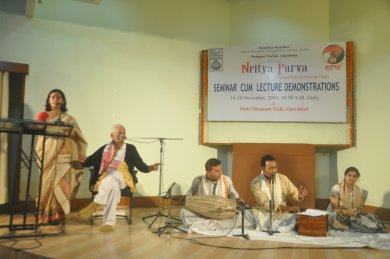 Guru Murari Mohan Sarma Renowned dance critic Leela Venkataraman expressed concern over the progress and documentation of the grammar, techniques and the various training processes of Sattriya dance in her talk entitled ‘Two streams together: Rituals and performance.’ She spoke of the performance situations and not theory, considering the rise in popularity of the dance style but the gradual fall in its quality. The teachings of bhakti by the “Gurujona,’ the philosophical and spiritual aspects of the Sattriya culture is often not paid heed to by many performers. The fate of the dance as a result of its travel from the Sattras (monasteries) to the proscenium was discussed in detail with the audience, gurus, scholars, performing artistes, learners and young bhakats actively participating in the discussions, giving their views and raising questions. Venkataraman stressed on the lack of integrated approach in the training processes of music, dance and literature that are present in the grooming and learning in the Sattras. She mentioned that the lack of a proper guideline calls for the need of a curriculum and structure or any codified document for the techniques considering the fact that Sattriya is a living tradition, the greatest advantage being its reference point of knowledge – the existing Sattras. She punctuated her talk with excerpts from her book ‘Indian Classical Dance: Renaissance and Beyond.’ Guru Jatin Goswami chaired this session offering his expert and insightful comments, adding that performers, gurus and those concerned should address the problems faced by the Sattriya culture. In spite of his poor health, Guru Murari Mohan Sarma, the renowned music director, guru and vocal artiste of Sattriya culture, especially the singing style of Bargeet of the Barpeta gharana, spoke on Bargeet and its accompanying instruments on the opening session of the third morning. He mentioned that it is important to follow the technique of Sargams and he is trying to do it with the instruments. This experiment was started from 2000 with the Nrityanjali Festival with Guru Jatin Goswami’s choreography of ‘Ram Bandana’ and the singers present demonstrated it with the Bhatima “Jaya Jaya Raghukula” adorned with the alankaras, of the play ‘Rama Bijoy.’ Meernanda Borthakur demonstrated “Govinda dudha pew,” the famous Borgeet of Shankaradeva originally sung in Shyam raga. Presently working as a teacher in the training project of Bargeet run by the Sattriya Kendra of Sangeet Natak Akademi, Sarma explained the difference and applications of mela raga and bandha raga in Bargeet stressing that Sattriya dance is “bhavashrayi”(bhava dependent) not Bolashrayi (not dependent on lyrics). Discussion and demonstration was with reference to geetarnach, Jhumara nach, prasangas (prayers) using Sri raga. With rhythm and the geets “Udhava chalaha Gokul” and the sloka “Shantakaram Bhujagashayanam” of Vishnu Vandana, the use of hastas and the way the dancer follows them was also demonstrated. 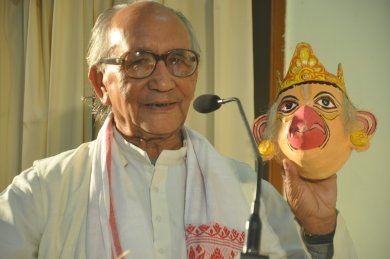 Rebakanta Mahanta  Mask making The last speaker was Rebakanta Mahanta, the recipient of the Sangeet Natak Akademi award for 2014 for contribution towards Sattriya mask-making traditions of Assam. The subject of mask-making was introduced for the first time in Nritya Parva and his lecture ‘Mask making of Khatpur Sattra’ was a vibrant and a highly interesting live session of mask-making by his students illustrating his lecture. Stating that masks of bull for Shiva and rajhans (swan) for Brahma and Garuda, Vishnu’s consort were made and used by Saint Shankaradeva in 1468 for his first play ‘Cihnayatra,’ he emphasized that wearing a mask enhances the expression and appeal of the character in Ankiya Bhaona, thus making it more attractive. While he tells his listeners holding a mask of Garuda, that Gurujon used to make masks from easily available materials from the natural surroundings of Assam so that these resources may be put to use, his students had already made the basic structure with cane sticks placing them cross-wise like a ‘Tummarmar’ (granary like structure). Generally bamboo, cane, earth, cloth and cow dung (for making eyes and the nose) are used. Now synthetic colours are applied but initially vegetable dyes were the obvious choice. Questions regarding the prospect of the art, preparation of decoration pieces other than the traditional ones for bhaona came flowing in. The audience responded readily to his talk and was curious to know the different types and sizes of the masks he makes. He mentioned that he had donated a 12ft mask of Sutradhar to Shankaradeva Kalakshetra years back. To demonstrate the use of large masks of demons, two actors wearing masks of “Rakhshasas” jumped onto the small stage to demonstrate a fighting sequence. Sattriya Kendra runs a mask-making project in his home and the prospect and interest by students are encouraging. Dulal Roy, former director of Sattriya Kendra, wrapped up the session with vibrant remarks. Raju Das, officer-in-charge, Sattriya Kendra Guwahati and his team, must be lauded for organizing such a meaningful seminar, worthwhile and educative. Dr. Nita Vidyarthi is a critic of performing arts, specialising in dance, dance theatre and expressions and is a regular contributor to The Hindu, and the Statesman Kolkata in dance, vocal music and theatre. She is trained in Kathak, Bharatanatyam and Manipuri as well as vocal, semi-classical music and Rabindra Sangeet. A Science communicator, Ph.D. in Polymer Science, Commonwealth Scholar and a retired Professor of Chemistry, Nita devotes most of her time to dance and theatre writing. |